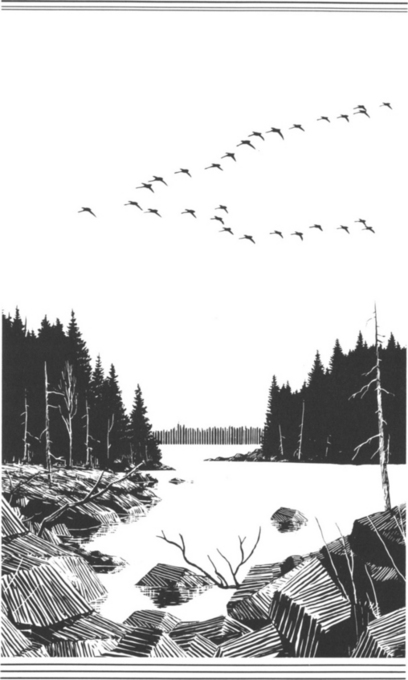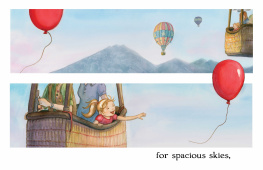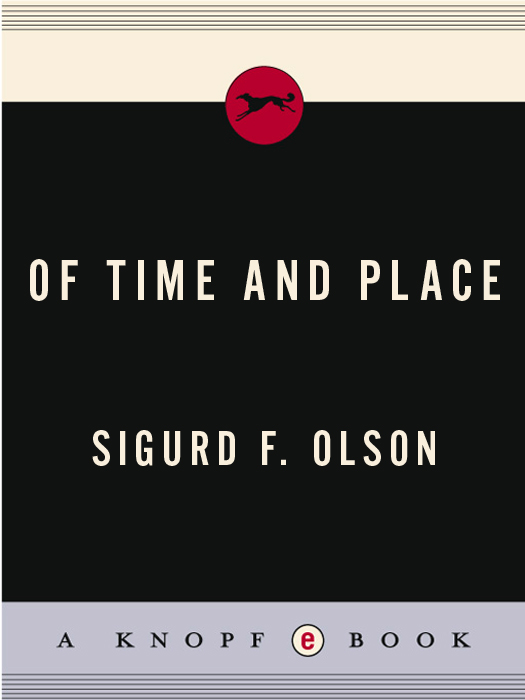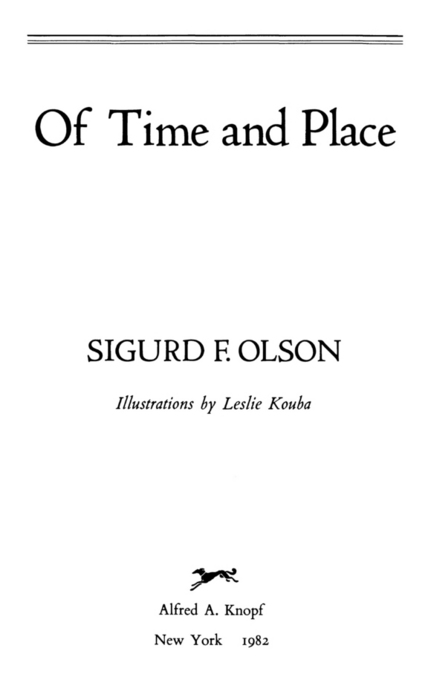ALSO BY SIGURD F. OLSON
The Singing Wilderness
Listening Point
The Lonely Land
Runes of the North
Open Horizons
Sigurd Olsons Wilderness Days
The Hidden Forest
Illustrated by Les Blacklock
Reflections from the North Country

THIS IS A BORZOI BOOK PUBLISHED BY ALFRED A. KNOPF, INC.
Copyright 1982 by The First National Bank of Duluth as Trustee for the Sigurd F. Olson Trust
Illustrations copyright 1982 by Leslie Kouba
All rights reserved under International and Pan-American Copyright Conventions. Published in the United States by Alfred A. Knopf, Inc., New York, and simultaneously in Canada by Random House of Canada Limited, Toronto. Distributed by Random House, Inc., New York.
Grateful acknowledgment is made to the following for permission to reprint previously published material:
Dodd, Mead & Company and McGraw-Hill Ryerson Ltd.: The Men Who Dont Fit In. Reprinted by permission of Dodd Mead & Company, Inc. From The Collected Poems of Robert Service. Copyright 1907, 1909, 1912 by Dodd, Mead & Company. Copyright 1916, 1921 by Dodd, Mead & Company, Inc. Copyright 1940 by Robert Service. And from The Collected Poems of Robert Service. Reprinted by permission of McGraw-Hill Ryerson Limited.
Charles Scribners Sons: George T. Marsh, The Old Canoe, in Scribners Magazine, October 1908. Copyright 1908 by Charles Scribners Sons; copyright renewed. Reprinted by permission of Charles Scribners Sons.
Library of Congress Cataloging in Publication Data
Olson, Sigurd F. [date]
Of time and place.
1. Natural historyUnited StatesAddresses, essays, lectures. I. Title.
QH 104.045 508.73 81-48097
eISBN: 978-0-307-82228-4 AACR 2
v3.1
To my family
Contents
Preface
The collection of experiences I have brought together in this book seems to fit into the broad pattern of what I have known in a lifetime of searching for meaning. Each experience is colored by my imagination and fantasy and grows out of an attachment to the land and a feeling for its antiquity. As I look back upon the many places I have been and upon the intimate relationships with natural things close to me, these vignettes are entwined in my thoughts and dreams.
No two individuals see the world in the same way. What has touched me may not affect you. But there is a common bond, for we are human, the only creatures on earth who can look at a scene with wonder and delight and sometimes with dismay. I have written about rocks, arrowheads, erratics, and mementos, things that have a very personal message for me. Some chapters tell of intangible things, mysterious and sacred things that have an emotional impact on our minds and spirits. And I also have talked about the great cycles of climatic change over which we have no control, the periods of drought, tornadoes, earthquakes, and glaciers. We simply accept them as inevitable, thankful we have survived, and have become convinced of the durability of the surface of the earth which we have been allowed to enjoy and love for a short time.
I offer this book to you in the hope you will find something of personal value, perhaps even a sense of recognition of some experiences in your own lives that resemble mine. Or perhaps it might be a guide to knowing; and if that turns out to be true, I shall be eternally grateful.
I wish to acknowledge the faith and encouragement of the members of my family, my wife, Elizabeth, Esther and Sigurd Jr., Yvonne and Robert. I especially wish to thank Ann Langen for the countless hours spent in editing the manuscript, also Angus Cameron, my esteemed editor, and his assistant, Barbara Bristol, who, in the books final preparation, did everything possible to make Of Time and Place a distinctive and beautiful volume.
I value Thomas Grays Elegy Written in a Country Churchyard, Sidney Laniers The Marshes of Glynn, William Cullen Bryants lovely poem To a Waterfowl, Robert W. Services The Men That Dont Fit In, and Henry Wadsworth Longfellows moving stanzas from Evangeline beginning This is the forest primeval.
 Of Time and Place
Of Time and PlaceOver the years the voyageurs, as we called ourselves, made many trips together retracing routes of the old voyageurs in their far-flung travels along the rivers and lakes during the days of the fur trade. No matter where we decided to go it was a joyous adventure, for we were one with them and with the explorers who mapped the far Northwest for the first time.
We ran the same rapids, knew the waves on the same big lakes, and suffered the same privations. Though ours was a modern age, we knew the winds still blew as they had then; the dim horizons looming out of the distance were no different from the mirages they had known. In the mornings we saw the same mists, resembling white horses galloping out of the bays. We knew all this, but most important was the deep companionship we found together. We had been most everywhere, and for us the North was much more than just terrain. We were part of its history.
Like men who had been in combat, we looked at the world through different eyes, for we had been tested in the crucible of wilderness travel and had not failed. The values we shared from our common experience are hard to explain, but without them life has no purpose. In my homeland of the Quetico-Superior and the wilderness canoe country, I often think of these values, which are in the land itself and in its rich history. The real importance of this region I know so well is not the vast deposits of minerals and timber or the part they play in our economy; the real importance lies in the values we find there and that we take with us when we leave, although we may not quite understand them.
I am always eager to renew old associations from my voyageur days. On one occasion I spent a few days with my old friend Tony Lovink. We headed west from the city of Ottawa and made a foray into the Gatineau country of southwestern Quebec, climbing to the very crest of the great escarpment.
It was autumn and the forests were gaudy with color. After a long steep ascent, we reached a bare ledge bathed in sunshine where we ate our lunch and rested on a grassy place, looking up at three ravens wheeling and soaring in the blue sky. Far below lay the fertile Ottawa Valley, broad and lush, the river winding its way west before it turned north to Lake Nipissing, then south to Georgian Bay and the beginning of the Great Lakes. Beyond was the misty horizon of the Laurentian divide, where the rivers run north to Ungava Bay of Quebec and Labrador.
I thought of the war between the French and the British in 1759 when General James Wolfe laid siege to the impregnable fortress of the city of Quebec. When the time came to storm the battlements, the British were faced on the Plains of Abraham by the brilliant Marquis de Montcalm. It was then that Wolfes thin red line was broken and both generals received grievous and fatal wounds. That day Quebec fell to British arms, and Frances dreams of an inland empire in the New World were swept away.










